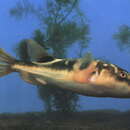en
names in breadcrumbs


Takifugu obscurus[7] or the obscure pufferfish is a species of euryhaline,[8] anadromous pufferfish first described by T. Abe in 1949.[2][3] It has been categorized by the IUCN as a least-concern species globally since 2014;[9] in South Korea, it is however classified as an endangered species due to overfishing of its endemic populations.[10] The Catalogue of Life lists no subspecies of Takifugu obscurus.[6] The species prefers deeper, clearer areas of brackish and fresh water,[2] and is found in estuaries, as well as rivers and tributaries thereof such as the South Korean rivers Geum, Han, and Imjin,[10] or the Tamsui River in mainland China.[2] The species is endemic to North and South Korea, the Sea of Japan, and the East and South China Seas. Uses of Takifugu obscurus include human consumption, use in animal testing, and owning specimens as pets. As with most species of pufferfish, several organs of Takifugu obscurus contain tetrodotoxin, making it potentially poisonous if not prepared safely by trained persons.
Takifugu obscurus is characterized by the following traits:[5]
{{cite web}}: Missing or empty |url= (help)CS1 maint: multiple names: authors list (link) {{cite web}}: CS1 maint: multiple names: authors list (link) {{cite journal}}: CS1 maint: multiple names: authors list (link) Takifugu obscurus or the obscure pufferfish is a species of euryhaline, anadromous pufferfish first described by T. Abe in 1949. It has been categorized by the IUCN as a least-concern species globally since 2014; in South Korea, it is however classified as an endangered species due to overfishing of its endemic populations. The Catalogue of Life lists no subspecies of Takifugu obscurus. The species prefers deeper, clearer areas of brackish and fresh water, and is found in estuaries, as well as rivers and tributaries thereof such as the South Korean rivers Geum, Han, and Imjin, or the Tamsui River in mainland China. The species is endemic to North and South Korea, the Sea of Japan, and the East and South China Seas. Uses of Takifugu obscurus include human consumption, use in animal testing, and owning specimens as pets. As with most species of pufferfish, several organs of Takifugu obscurus contain tetrodotoxin, making it potentially poisonous if not prepared safely by trained persons.